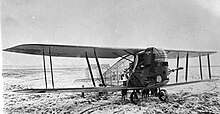This article needs additional citations for verification. (September 2014) |



Counter-rotating propellers (CRP) are propellers which turn in opposite directions to each other.[1] They are used on some twin- and multi-engine propeller-driven aircraft.
The propellers on most conventional twin-engined aircraft turn clockwise (as viewed from behind the engine). Counter-rotating propellers generally turn clockwise on the left engine and counterclockwise on the right. The advantage of such designs is that counter-rotating propellers balance the effects of torque and P-factor, meaning that such aircraft do not have a critical engine in the case of engine failure.
Drawbacks of counter-rotating propellers come from the fact that, in order to reverse the rotation of one propeller, either one propeller must have an additional reversing gearbox, or the engines themselves must be adapted to turn in opposite directions. (Meaning that there are essentially two engine designs, one with left-turning and the other with right-turning parts, which complicates manufacture and maintenance.)